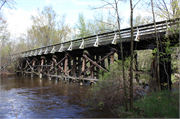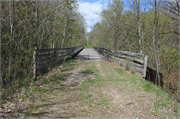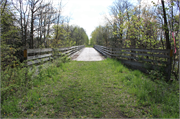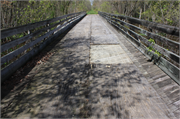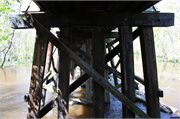| Additional Information: | A 'site file' exists for this property. It contains additional information such as correspondence, newspaper clippings, or historical information. It is a public record and may be viewed in person at the Wisconsin Historical Society, State Historic Preservation Office.
2024:
DESCRIPTION
The Little River Trestle is on the alignment of the Oconto River State Trail over the Little River in the Town of Stiles, Oconto County in northeastern Wisconsin. The Oconto River State Trail is an 8-mile multi-use recreation trail that traverses forested and agricultural lands between the communities of Oconto and Stiles Junction. The trail is on the alignment of the former Oconto–Clintonville line of the Chicago & North Western Railway. In 1997, the former railroad line was acquired by the State of Wisconsin and converted into a multi-use recreational trail under the Rails to Trails Program between 1998 and 2002.
The Little River Trestle is a wood pile railroad trestle type bridge constructed circa 1882. It is approximately 168 feet long from abutment to abutment and approximately 10 feet wide. The approach to the bridge is a grass covered earthen berm with a limited crushed stone surface. The trail is buffered along its north and south edges by mature trees and vegetative undergrowth.
The superstructure consists of two sets of three closely placed, hewn timber stringers that are bolted together and set directly on the substructure components formerly below the alignment of the railroad tracks. Hewn timber railroad ties are laid perpendicular on top of the timber strings. Above the railroad ties, the superstructure was entirely reconstructed as part of the rail to trail conversion. Addition floor beams, which are dimensional lumber posts, have replaced select ties at regular intervals across the span. The rails have been removed and replaced with dimensional lumber laid diagonally. Side-by-side sheets of plywood have been laid on the diagonal decking, potentially to deter accelerated deterioration to the decking during the winter snow mobile season. The north and south edges of deck are flanked by a 4-rung dimensional lumber railing that is secured with external knee braces attached at each of the floor beams.
The substructure consists of stacked timber abutments below the east and west approaches of the bridge and a series of closely spaced wood pile bents. From bottom to top, a typical bent consists of a horizontal mud sill, five vertical piles, and a horizontal cap. The mud sill is comprised of two horizontal hewn timber beams with perpendicular timber spacers. Of the five piles, the three vertical interior piles are nailed directly to the mud sill. Two angled exterior piles, one at either of the outer ends, appear to be driven into the ground. (WisDNR provided photographs captured in fall while the water level was low; however, at the time of survey, the mud sills were submerged and not visible.) The piles are both hewn timbers and round, stripped log timbers. A horizontal hewn timber cap is fixed atop the five piles. Diagonal sawn lumber braces are bolted across the piles of each bent as lateral sway bracing. Additional diagonal and perpendicular sawn lumber braces are bolted between the bents as longitudinal bracing.
HISTORIC CONTEXT:
In 1879, the St. Paul Eastern Grand Trunk Railway was organized with ultimate goal of creating a line between Oconto and St. Paul, Minnesota. The St. Paul Eastern Grand Trunk Railway, under contract with the Milwaukee, Lakeshore & Western Railway, undertook the construction of the 56 mile line completed between Oconto and Stiles Junction in 1882. Based on varying accounts, the line opened for travel between December 29, 1882, and January 1, 1883. At Stiles Junction, the Oconto-Clintonville branch connected with the Milwaukee & Northern (Chicago, Milwaukee, & St. Paul Railroad). The Oconto-Clintonville line was completed to Clintonville in 1884 at which time the branch was leased to the Milwaukee, Lake Shore & Western Railroad and became known as the Oconto division of that railroad. By 1893, the total trackage of the Milwaukee, Lake Shore & Western Railroad was acquired by the Chicago & North Western Railway and the Oconto-Clintonville branch became part of its Lakeshore Division Peninsula District.
wood bridge |
|---|

